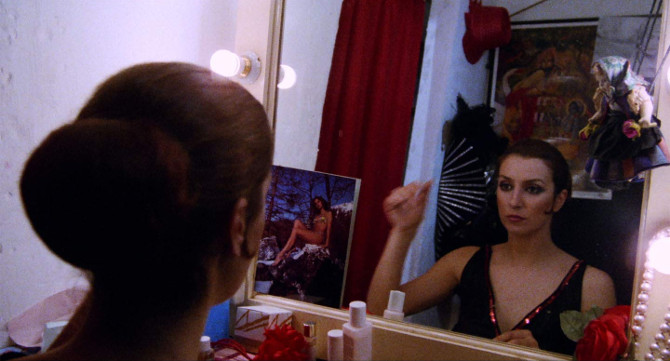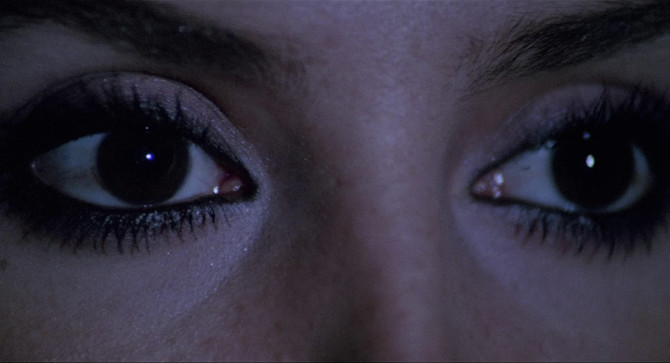Produced towards the end of the giallo craze, director Antonio Bido’s 1977 film, which had different titles for the major markets in which it played. . . in Italy – The Cat with the Jade Eyes (good luck figuring out how this ties to the movie in any way), in the UK – The Cat’s Victims (again, loose ties at best), in the U.S. – Watch Me When I Kill (again, not very accurate), in France – Terror in the Lagoon (not sure where the Creature was. . . or the lagoon, for that matter), in Germany – The Vote of Death (finally one that may just make sense), takes the prototypical giallo themes and flips them on their head.
Not psycho sexually driven or overly graphic in its violence, the story follows a guarded dancer, Mara (Paola Tedesco), who just seems to draw people in. Performing different routines on the stage of a nightclub (keep those minds out of the gutter everyone, think tango rather than striptease), Mara finds so-called filmmakers pestering her to join their project (hoping to get her into bed as well), a needy dance partner who is always keeping an eye on her, and her former fling, Lukas (Corrado Pani), coming around to rekindle their sporadic romance.
Shrugging them all off, she has the bad luck of stopping at a pharmacy. . . no, not because they carry No Name brand drugs, but because the pharmacist has just been murdered by a off-white surgical gloved (changing things from the typical black) killer – making her a witness to a crime that she never really saw.
Being the private individual she is, Mara decides to leave the scene, never checking in with the police. Yet, this killer (who, for some reason, has a cat sound and graphic appear when he/she murders someone – which, I guess makes them the ‘cat killer’), doesn’t appreciate having any loose ends. . . meaning that this talented dancer will have this person’s claws sunk into her for the foreseeable future.
Looking to Lukas for help, the playboy sound-mixing expert gladly invites the woman into his home. . . a guest with benefits and detriments. Becoming a makeshift detective (this trope is not vanquished in this picture), Lukas begins to investigate this most mysterious case. Soon, his shady neighbour, elderly Giovanni Bozzi (Fernando Cerulli), a bookie who never has women over, is returning home with. . . a woman, Esmeralda Messori (Bianca Toccafondi). Furthering his unusual behaviour, the very reclusive man also comes to Lukas looking for help. . . for he has received a number of alarming crank calls (with darkly disturbing sounds interwoven together) – isn’t it great having a sound-mixing expert as a next door neighbour.
Soon, Lukas is starting to put a few of the pieces together, as a convicted murderer, Pasquale Ferrante (Franco Citti), has escaped from prison – his jury consisting of the aforementioned pharmacist, neighbour, as well as several others. Could it really be this simple? Lukas isn’t sure, but he begins to warn those who may be in the killer’s path, including the trial’s Judge (Giuseppe Addobbati).
Competently made, Bido does not infuse the film with the almost expected visual style that usually comes along with a giallo, instead letting the setting and story add the flourishes. Though you won’t see the fantastical reflections, intense angles, over-the-top chiaroscuro lighting, violent visuals, and excessive nudity (in fact, the only nude seen is the aforementioned elderly neighbour in a rather lengthy bathtub sequence – talk about titillation. . . in fact, it is an impressive scene with dramatic opera playing in the background), the story, written by four people, including Vittorio Schiraldi (who came up with the premise and wrote the screenplay) and Bido himself, develop a wide array of intriguing murder mystery scenarios. One twitchy sequence finds someone cooking. . . only to believe that there may be someone in their home – the many steps leading to different rooms, along with a very human-like coat hanger, build the suspense along the way. Another moment finds Mara going to the storage room to retrieve her costume – with many of the aforementioned players in the club, she enters a claustrophobic room lined by numerous outfits, creepy mannequins, and all kinds of other tchotchkes. . . the lights going out before she has the chance to leave.
A story about young and old, as well as looking back and answering questions about your past, this film (no matter which title you choose – I’ll make up my own and go with The Sadistic Sound of Revenge) has a conclusion that is not like your typical giallo ending (in fact, it is a one of a kind). Matched onscreen with a killer prog rock score (the group of musicians, including Gianfranco Coletta and Mauro Lusini, decided to take the name Trans Europa Express in direct tribute of German band Kraftwerk’s sixth album), for all of its catchy, toe tapping moments, it also brings forth the creep factor when needed. Lastly, keep an eye out – and I use the word eye, for the number of peepers Bido shows throughout the film – statues, paintings, mannequins, closeups of the players, masks – this, in many ways, is an example of his subtle style (furthering his theme of watching, spying, and surveillance). So, judge for yourself whether this unusual take on the giallo is for you. . . and while you’re at it, take a stab at developing your own creative title.
Can be watched in either Italian with English subtitles or in dubbed English




